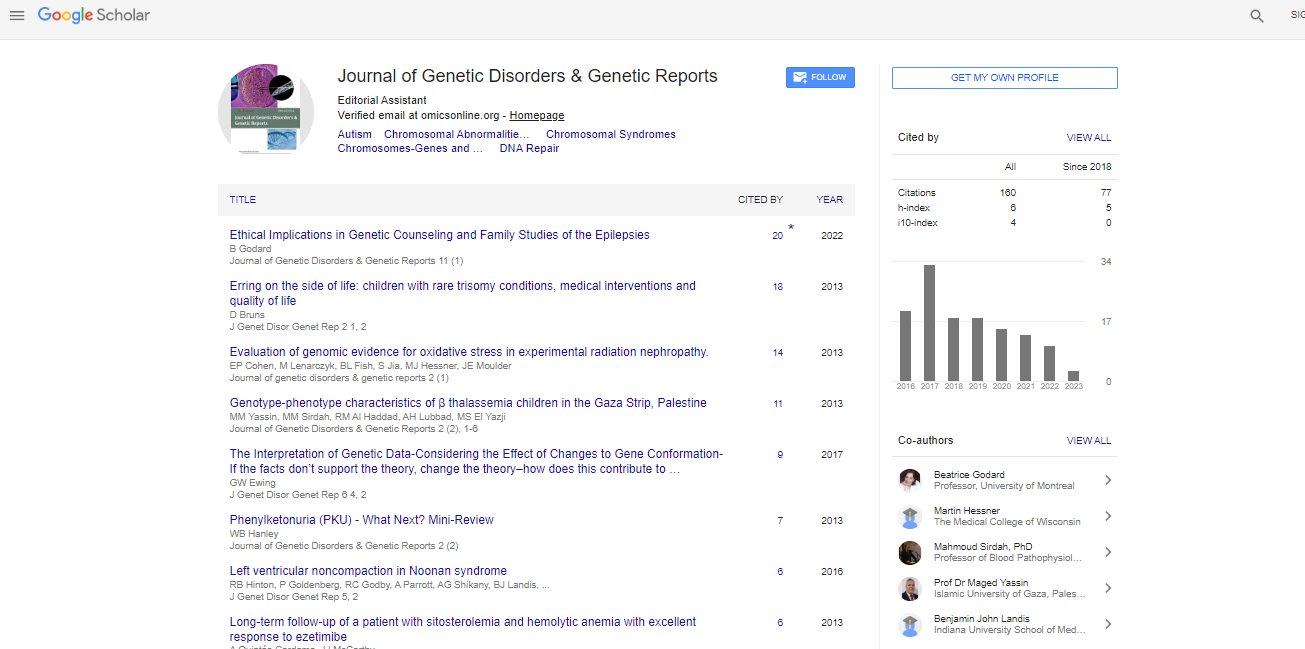Opinion Article, J Genet Disor Genet Rep Vol: 12 Issue: 4
Ehlers-Danlos Syndrome: Subtypes and Diagnostic Advances Explored
Eric Romano*
1Department of Molecular Genetics, Harvard University, Cambridge, Massachusetts, USA
*Corresponding Author: Eric Romano,
Department of Molecular Genetics, Harvard
University, Cambridge, Massachusetts, USA
E-mail: romanoeric02@gmail.com
Received date: 25 July, 2023, Manuscript No. JGDGR-23-113889;
Editor assigned date: 28 July, 2023, PreQC No JGDGR-23-113889(PQ);
Reviewed date: 11 August, 2023, QC No JGDGR-23-113889;
Revised date: 21 August, 2023, Manuscript No JGDGR-23-113889(R);
Published date: 28 August, 2023, DOI: 10.4172/2576-1439.1000221.
Citation: Romano E (2023) Ehlers-Danlos Syndrome: Subtypes and Diagnostic Advances Explored. Int J Genet Dis Genet Rep 12:4.
Abstract
Description
Ehlers-Danlos Syndrome (EDS) is a group of rare hereditary connective tissue disorders characterized by a wide range of symptoms, primarily affecting the skin, joints, and blood vessels. Understanding the various subtypes of EDS and the diagnostic methods available is crucial for early intervention and tailored management. In this article, we provide a comprehensive overview of EDS, focusing its subtypes, clinical manifestations, and diagnostic approaches.
Subtypes of Ehlers-Danlos syndrome
There are currently thirteen recognized subtypes of EDS, each with distinct clinical features and genetic causes. Here, we explore some of the most common subtypes:
Classical EDS (cEDS): cEDS is characterized by hyperelastic skin, joint hypermobility, and a predisposition to easy bruising. Mutations in COL5A1 and COL5A2 genes, which encode collagen type V, are responsible for this subtype.
Hypermobility EDS (hEDS): hEDS primarily affects joint flexibility, often leading to joint dislocations and chronic pain. It is considered the most common subtype and may not always present with skin involvement. Genetic factors for hEDS are not yet fully understood.
Vascular EDS (vEDS): vEDS is a life-threatening subtype characterized by fragile blood vessels, which can result in arterial and organ ruptures. Mutations in the COL3A1 gene, responsible for collagen type III production, underlie this subtype.
Kyphoscoliotic EDS (kEDS): kEDS is marked by severe muscle weakness, joint dislocations, and progressive scoliosis. It is caused by mutations in genes involved in collagen synthesis.
Clinical manifestations
The clinical features of EDS can vary widely among individuals and subtypes. Common manifestations include
Joint hypermobility: EDS often leads to joint instability, dislocations, and chronic pain.
Skin abnormalities: Hyperelastic, fragile skin that bruises easily is a indication feature.
Wound healing issues: Slow wound healing and atrophic scarring are common.
Vascular complications: VEDS is associated with life-threatening vascular issues.
Gastrointestinal problems: Gastrointestinal symptoms, such as acid reflux and irritable bowel syndrome, may occur.
Diagnostic approaches
Diagnosing EDS requires a multidisciplinary approach, involving clinical evaluation and genetic testing:
Clinical assessment: Physicians skilled in connective tissue disorders conduct a thorough physical examination, assess family history, and use standardized criteria to diagnose EDS.
Genetic testing: Molecular genetic testing can identify mutations in the relevant genes associated with specific subtypes, confirming the diagnosis.
Differential diagnosis: EDS may be mistaken for other conditions, such as Hypermobility Spectrum Disorders (HSDs) or Marfan syndrome. Differential diagnosis is essential for accurate classification.
Management and treatment
There is currently no cure for EDS, but management strategies aim to alleviate symptoms and improve the quality of life:
Symptomatic relief: Treatment may involve pain management, physical therapy, and orthopedic interventions to address joint instability.
Skin care: Careful wound management and scar prevention techniques can mitigate skin-related issues.
Cardiac monitoring: VEDS patients require vigilant cardiac surveillance to detect and manage vascular complications.
Genetic counseling: Individuals and families benefit from genetic counseling to understand the inheritance pattern and make informed decisions.
Conclusion
Ehlers-Danlos Syndrome is a complex group of connective tissue disorders, each with its unique clinical features and genetic basis. Early and accurate diagnosis, as well as a multidisciplinary approach to care, are crucial for managing the condition effectively. While there is no cure, ongoing research into EDS genetics and symptom management indicates for improved treatments and better outcomes for those living with this challenging condition. Increasing awareness and support for individuals and families affected by EDS is vital in ensuring they receive the comprehensive care they need to navigate the complexities of this syndrome.
 Spanish
Spanish  Chinese
Chinese  Russian
Russian  German
German  French
French  Japanese
Japanese  Portuguese
Portuguese  Hindi
Hindi 



